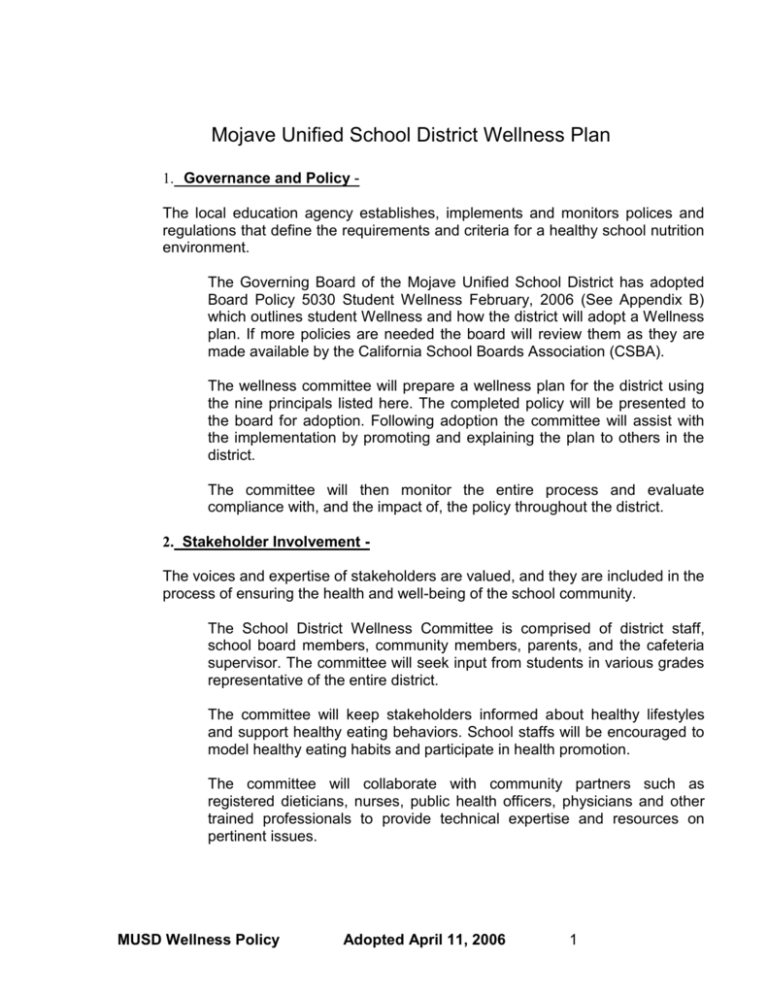Wellness Booklet - Mojave Unified School District
advertisement

Mojave Unified School District Wellness Plan 1. Governance and Policy The local education agency establishes, implements and monitors polices and regulations that define the requirements and criteria for a healthy school nutrition environment. The Governing Board of the Mojave Unified School District has adopted Board Policy 5030 Student Wellness February, 2006 (See Appendix B) which outlines student Wellness and how the district will adopt a Wellness plan. If more policies are needed the board will review them as they are made available by the California School Boards Association (CSBA). The wellness committee will prepare a wellness plan for the district using the nine principals listed here. The completed policy will be presented to the board for adoption. Following adoption the committee will assist with the implementation by promoting and explaining the plan to others in the district. The committee will then monitor the entire process and evaluate compliance with, and the impact of, the policy throughout the district. 2. Stakeholder Involvement The voices and expertise of stakeholders are valued, and they are included in the process of ensuring the health and well-being of the school community. The School District Wellness Committee is comprised of district staff, school board members, community members, parents, and the cafeteria supervisor. The committee will seek input from students in various grades representative of the entire district. The committee will keep stakeholders informed about healthy lifestyles and support healthy eating behaviors. School staffs will be encouraged to model healthy eating habits and participate in health promotion. The committee will collaborate with community partners such as registered dieticians, nurses, public health officers, physicians and other trained professionals to provide technical expertise and resources on pertinent issues. MUSD Wellness Policy Adopted April 11, 2006 1 3. Student Involvement The voices of students are valued, and they are included in developing strategies to ensure students’ nutritional health and well-being. Students will be polled at various sites and grade levels to seek their advice on types of foods to be served. Students will be polled on how to better implement physical education into the curriculum at all grade levels. Students will be encouraged to make menu suggestions, be involved in designing meal service areas, and creating multiple options to expedite meal service in order to accommodate all students on the various campuses in the district. The committee will help plan schoolwide activities that encourage good nutrition. The committee will help plan times for the district cafeteria director to meet with student councils to discuss and explain nutrition guidelines. 4. Nutrition Education Nutrition is an integral component of the kindergarten through twelfth grade curriculum, teaching, and assessments. The school board is encouraged to adopt and staff to implement a nutrition education program that adheres to USDA dietary guidelines (see principal 5) The district is encouraged to teach health education to all students, and to integrate nutrition knowledge and skills across the curriculum at specific grade levels. Staff development should be provided for classroom teachers on basic nutrition and evidence-based instructional strategies that build skills. Staff should be shown how to connect between what is taught in the classroom, what is served in the cafeteria, and what is available in the surrounding community. MUSD Wellness Policy Adopted April 11, 2006 2 5. Access and Participation The LEA designs and fully implements plans to provide access to all school nutrition programs at all schools, where cost effective, and to reach and maintain maximum student participation. All students in grades K-12 are offered meals through the National School Lunch Program. Those who qualify are offered free and reduced meals. Meals are served using those guidelines for nutrition following federal USDA rules and regulations for portion control and type of foods served. The regulations are as follows: -Only 100% fruit juice, plain or carbonated, with not added sweeteners, no caffeine or herbal supplements, with a maximum size of 12 oz. -Only 1% or fat free milk. Flavored milk may contact no more than 40 g of sweetener. Portions of various foods and types are listed in Appendix A of this document -Foods served outside the cafeteria(vending machines, etc.): -Restrict entree items sold to no more than 400 calories and four grams of fat per 100 calories -Restrict snack items sold to no more 175 calories per individual food item for elementary schools and 250 calories for middle and high schools -Exempt food sold at least one-half hour after the end of the school day, off school campus, or during a school sponsored pupil activity that occurs after the end of the school day. -Expand the existing ban on soda sales in elementary and middle school to high schools, beginning July 1, 2006. -Limit beverages that can be sold to milk, non-sweetened water, and fruit and vegetable based drinks composed of no less than 50% or more fruit or vegetable juice with no added sweeteners -Allow sales of certain electrolyte replacement beverages (sports drinks) at junior high and high schools -Prohibit sales of soda at school beginning one half hour before the start of school until one half hour after school ends. -Exempt students’ sodas brought on campus form home -Food courts are permitted at junior high and high schools to only four days during the school year when any number of organizations may sell items. Otherwise schools are permitted to have only one organization sell each day. Minimize the time students have to stand in line for meals. MUSD Wellness Policy Adopted April 11, 2006 3 6. Healthy School Environment The LEA provides a whole school environment that models, supports and encourages lifelong healthy nutrition habits. Ensure that there is a sufficient well-trained staff and adequate clean facilities in which to prepared meals. Ensure that all meals are prepared so they are presented in an appealing manner and are easily accessible from multiple locations on campus. Ensure that all foods sold or served on campus reflect a commitment to healthy eating behaviors. The principal and committee will encourage all school staff and guests to model healthy heating behaviors by ensuring that all foods available to staff and guests are consistent with state and local nutrition standards for competitive foods. Encourage teacher to replace food rewards in class with low cost gifts. Encourage physical activities. The committee will ensure that students are given more opportunities to participate in physical activities, such as intramurals. The district will hire intra-mural supervisors to offer such events at lunch at recess at the various school sites. The district will also research and apply for grants that will allow the district to hire P.E. teachers for the elementary grades. 7. Funding The LEA maximizes funding to ensure all nutrition standards for meals are following and that provisions are made for adequate facilities to improve access to and the quality of meals so that participation targets can be met. The principal and committee will involve stakeholders and community partners to develop new sources of funding and to explore ways to leverage resources through collaborations with other organizations and agencies. The principals will work with the district to ensure that all school related fund-raising efforts promote only health food and beverages or involve non-food items and activities. Many such changes can be done without additional revenues. MUSD Wellness Policy Adopted April 11, 2006 4 8. Professional Development The LEA provides continuous professional development, learning, and collaboration opportunities to ensure all staff have the knowledge and skills necessary to design and deliver high quality nutrition policies, standards, programs, partnerships, and to design and offer physical activities, games, and exercise. The district is encouraged to support professional development on how to integrate nutrition education across the curriculum and on multiple approaches for assessing student progress. Offer training on how to incorporate nutrition education resources into standards-based lesson plans. Bring in health professionals to offer professional development. The district will provide professional training for staff to develop a Physical Education handbook with lesson plans and training for daily Physical Education strategies. 9. Continuous Monitoring and Accountability School Districts (including student and parent organizations and partners as well as all staff) are accountable for full implementation of nutrition polices and standards. The committee will review and update nutrition plans and polices as changes come from the state of California. The committee will use assessment data to improve the quality of school nutrition programs, increase participation rates, and monitor adherence to nutrition policies. The committee will include the following evaluation goals, and may develop others as needed: -The number of the student population which buys lunch will increase by five percent the first year. -Physical fitness activities of students will increase daily by ten minutes. The percentage of teachers who are trained in nutrition education in the classroom will increase by ten percent the first year. The percentage of teachers who are using nutritional education the classroom will increase by ten percent. MUSD Wellness Policy Adopted April 11, 2006 5 Nutrition Services Division To: School Districts and County Offices of Education Number: 05-109 Attention: Superintendents, Business Officers, and Food Service Directors Date: August 2005 Subject: Requirements for Beverage Sales Exclusive of the School Nutrition Programs Reference: Senate Bill 677 (Ortiz), Chapter 415, Statutes of 2003 This Management Bulletin (MB) amends and supersedes MB 04-114 issued November 2004. This MB deletes language found in MB 04-114 that implied that a school containing any elementary grades must abide by beverage standards applying to elementary schools. As amended, this MB provides definitions for elementary, middle, and high schools (as defined in Education Code [EC] 49430) that clarify which beverage standards a school must follow. Therefore, by statutory definition, a school containing no grade higher than six (e.g., K-5, K-6, K3, 4-6, etc.) follows elementary school beverage standards. A school containing grades seven, eight, but no grade higher than nine (e.g., K-8, 7-8, 7-9, etc.) follows middle school beverage standards. A school containing grades ten, eleven, or twelve (e.g., 7-12, 9-12, 10-12, etc.) is considered a high school. This amended MB also provides clarification on types of milk acceptable for middle and junior high schools and provides information on the implementation of Senate Bill (SB) 677 (Ortiz) (Chapter 415, Statutes of 2003), referred to as the California Childhood Obesity Prevention Act of 2003. The intent of this legislation is to improve the eating behaviors of California's school children by allowing only certain beverages for sale on school campuses during school hours. The legislation does not address food sales. SB 677 adds EC 49431.5 which, effective July 1, 2004, defines beverage standards for elementary, middle, and junior high schools. Highlights of the new law are as follows: Definitions (EC 49430) An elementary school includes kindergarten through grade six, but no grade higher than grade six. A middle school includes grades seven or eight, but no grade higher than grade nine. A high school includes grades ten to twelve. MUSD Wellness Policy Adopted April 11, 2006 6 Beverage Sales 1. Elementary Schools The only beverages that may be sold to students in elementary schools during the school day are water, milk, 100 percent fruit juices, and fruit-based drinks that are composed of no less than 50 percent fruit juice and have no added sweeteners. This does not preclude the sale of carbonated beverages that meet the above requirements. Beverages that do not meet the above criteria may be sold for fundraising under the following circumstances: o Students sell the beverages off the school grounds or o Students sell the beverages on school grounds at least one-half hour after the end of the school day. 2. Middle and Junior High Schools The only beverages that may be sold to students in middle and junior high schools are water; milk, including, but not limited to chocolate milk, soy milk, rice milk, and other similar dairy or nondairy milk; 100 percent fruit juices; fruit-based drinks that are composed of no less than 50 percent fruit juice and have no added sweeteners; and electrolyte replacement beverages that contain no more than 42 grams of added sweetener per 20-ounce serving. This does not preclude the sale of carbonated beverages that meet the above requirements. This law applies from one-half hour before the start of the school day to one-half hour after the end of the school day. Beverages that do not meet the above criteria may be sold for fundraising under the following circumstances: o The sale occurs during and at the location of a school-sponsored event after the end of the school day or o The sale occurs via vending machines, student stores, and cafeterias no sooner than one-half hour after the end of the school day. 3. Vending Machine Policy Elementary, middle, or junior high schools may use vending machines to offer beverages that comply with the above criteria at any time of day. Middle or junior high schools may use vending machines to offer beverages that do not comply with the above criteria if they are made available no later than one-half hour before the start of the school day and no sooner than one-half hour after the end of the school day. 4. Definition of "Added Sweetener" "Added sweetener" means any additive that enhances the sweetness of the beverage, including, but not limited to, added sugar, except the natural sugar or sugars that are contained within any fruit juice that is a component of the beverage. MUSD Wellness Policy Adopted April 11, 2006 7 USDA Food and Nutrition Service www.usda.gov/cnd/menu/fmnv.htm Foods of Minimal Nutritional Value The following is taken from Appendix B of 7 CFR Part 210. Minimal Nutritional Value Appendix B to Part 210--Categories of Foods of (a) Foods of minimal nutritional value--Foods of minimal nutritional value are: (1) Soda Water--A class of beverages made by absorbing carbon dioxide in potable water. The amount of carbon dioxide used is not less than that which will be absorbed by the beverage at a pressure of one atmosphere and at a temperature of 60 deg. F. It either contains no alcohol or only such alcohol, not in excess of 0.5 percent by weight of the finished beverage, as is contributed by the flavoring ingredient used. No product shall be excluded from this definition because it contains artificial sweeteners or discrete nutrients added to the food such as vitamins, minerals and protein. (2) Water Ices--As defined by 21 CFR 135.160 Food and Drug Administration Regulations except that water ices which contain fruit or fruit juices are not included in this definition. (3) Chewing Gum--Flavored products from natural or synthetic gums and other ingredients which form an insoluble mass for chewing. (4) Certain Candies--Processed foods made predominantly from sweeteners or artificial sweeteners with a variety of minor ingredients which characterize the following types: (i) Hard Candy--A product made predominantly from sugar (sucrose) and corn syrup which may be flavored and colored, is characterized by a hard, brittle texture, and includes such items as sour balls, fruit balls, candy sticks, lollipops, starlight mints, after dinner mints, sugar wafers, rock candy, cinnamon candies, breath mints, jaw breakers and cough drops. (ii) Jellies and Gums--A mixture of carbohydrates which are combined to form a stable gelatinous system of jelly-like character, and are generally flavored and colored, and include gum drops, jelly beans, jellied and fruit-flavored slices. (iii) Marshmallow Candies--An aerated confection composed as sugar, corn syrup, invert sugar, 20 percent water and gelatin or egg white to which flavors and colors may be added. (iv) Fondant--A product consisting of microscopic-sized sugar crystals which are separated by thin film of sugar and/or invert sugar in solution such as candy corn, soft mints. MUSD Wellness Policy Adopted April 11, 2006 8 (v) Licorice--A product made predominantly from sugar and corn syrup which is flavored with an extract made from the licorice root. (vi) Spun Candy--A product that is made from sugar that has been boiled at high temperature and spun at a high speed in a special machine. (vii) Candy Coated Popcorn--Popcorn which is coated with a mixture made predominantly from sugar and corn syrup. *Grades K-3: This is an optional age/grade group. USDA recommends using it along with others. MUSD Wellness Policy Adopted April 11, 2006 9 MEAL PATTERN FOR LUNCH – ENHANCED FOOD-BASED MENU PLANNING AGES 1-2 YRS Meat/ Meat Alternate Fruits/Vege tables Grains/Bre ads Milk (Fluid) PRESCHOO L GRADE S K-6 GRADES 7-12 1-1 ½ oz 2 oz 2 oz 1-1 1/2 oz ½ cup 3/4 cup** **plus an extra ½ cup over a week. 1 cup ¾ cup 5 serv ½ serv 8 serv 12 1 serv serv 1 serv 15 serv 1 serv 10 serv 1 serv 6 fl oz 6 fl oz 8 fl oz 8 fl oz Per day serving of the following food 1 oz items or a combination of these items to provide at least the quantity listed. The quantities are the edible portion as served. At least two different vegetables and/or ½ fruits must be offered. Minimum cup requirements per day… Must be enriched or whole grain or contain germ or brand. A serving is: A slice of bread or an equivalent serving of biscuits, rolls, etc. OR ½ cup cooked rice, macaroni, noodles, other pasta products or cereal grains. Up to one serving per day may be a grain-based dessert. (This applies only to Grades K-12, not to Ages 1-2 and PreSchool) Minimum per WEEK Minimum per DAY In this chart, a week equals 5 days. If there are 7 days in the week, increase servings of Grains/Breads per week by: 5 servings for Grades K-6 to a total of 17 servings 6 servings for Grades 7-12 to a total of 21 servings Increasing the number of servings of Grains/Breads is critical to the success of meeting the calorie requirements and implementing the Dietary Guidelines recommendations for dietary fiber. Must be served as a beverage. MUSD Wellness Policy Adopted April 11, 2006 8 fl oz 10 GRADES K-3* NUTRITION STANDARDS Averaged over the School Week For all of the School Meals Initiative Menu Planning Approaches (except the Traditional Menu Planning Approach) SCHOOL LUNCH PROGRAM Minimum Requirements for Nutrient and Calorie Levels Category Nutrients and Energy Allowances Energy Allowance (Calories) Total Fat (as a percentage of total calories) Saturated Fat (as a percentage of total calories) Protein (g) Calcium (mg) Iron (mg) Vitamin A (RE) Vitamin C (mg) Minimum Requirements Prescho ol Optional Grades K-6 Grades 7-12 Grades K-3 517 664 825 633 * * * * ** ** ** ** 7 267 3.3 150 14 10 286 3.5 224 15 16 400 4.5 300 18 9 267 3.3 200 15 SCHOOL BREAKFAST PROGRAM Minimum Requirements for Nutrient and Calorie Levels Category Minimum Requirements Nutrients and Energy Preschool Allowances Energy Allowance 388 (Calories) Total Fat (as a percentage of total * calories) Saturated Fat (as a percentage of total ** calories) Protein (g) 5 Calcium (mg) 200 Iron (mg) 2.5 Vitamin A (RE) 113 Vitamin C (mg) 11 * Not to exceed 30 percent over a school week. Optional Grades K -12 Grades 7-12 554 618 * * ** ** 10 257 3.0 197 13 12 300 3.4 225 14 ** Less than 10 percent over a school week. MUSD Wellness Policy Adopted April 11, 2006 11 MUSD Wellness Policy Adopted April 11, 2006 12 MUSD Wellness Policy Adopted April 11, 2006 13








